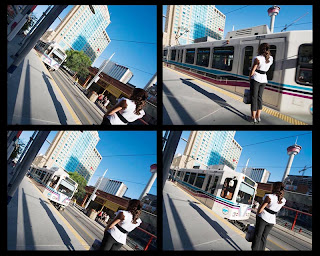 Week 6
Week 6The Actionsampler is an inexpensive camera with 4 plastic lenses and a shutter mechanism that records pictures about 1/4 of a second apart on a standard frame of 35mm film. The camera is fixed focus, fixed aperture, and fixed shutter speed. Just point and push the button for four quick shots. The camera arranges the shots sequentially from upper left counter clockwise around to upper right.
To get this kind of shot with an SLR is easy but takes some post processing after the shot. Every shot should have the same exposure so I set my camera to manual ISO 200, aperture of f13, and shutter speed of 200. This is just one stop off the "sunny 16" rule and maybe I cheated a little because I used my meter and a test shot before shooting the series. I wanted depth of field and pretty fast shutter speed. Focal length is 16mm so very wide angle on full frame. It turns out the lag between shots I'd set for shooting speed when the shutter button is held down was 1/3 second instead of 1/4 second. It was late in the day - see the long shadows? - and the light was warm and dropping off a little. I cropped each frame to 8x10 after the shot. A D3 with a Nikkor 14-24 f2.8 makes for a pretty expensive Actionsampler but it does get the job done. Then it is just a matter of bringing all 4 pictures in as layers in Photoshop and pasting them in order.
When I made this series I was sitting on a bench waiting for trains to come by. I had done a couple of my patented "engineer style" shots where I held the camera perfectly level, nicely framed, nobody was in the shot, etc. Boring, boring, boring. So I came up with the idea of rotating the camera as I shot. Believe me, this type of creativity is difficult for an engineer. About that time the young lady came up and stood just in the frame. What luck! I like the way it is framed but there seems to be too much going on. See this shot in my blog for a more cropped and straightened version of the last frame: Apparently Random Travel Blog
I noticed after I had done this that it looked kind of cartoonish. You know, wacky angles and frames and what not. So I tried fooling around with the colors a bit in the shot below. I think the wide angle works well - might try a fisheye. You want the action coming at you I think but it would be worthwhile looking at it going away. I did something like this at Erica's wedding with the bouqet and garter toss sequences but at a right angle and with more frames. Kind of fun....
Idea based on Four Times More Fun, pages 42-43 in the book 50 Photo Projects, by Lee Frost



